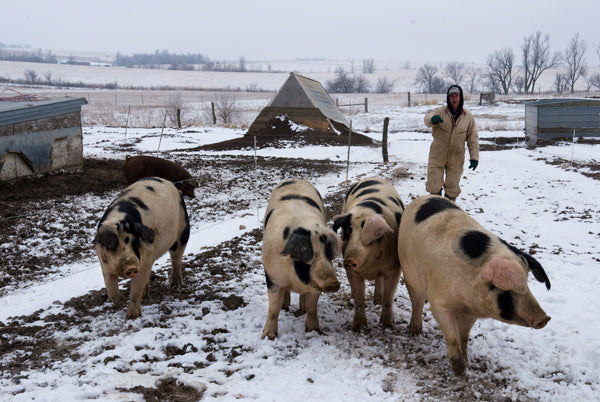
Honoring the Old Spot
The Gloucestershire Old Spot is the aristocrat of the pig world. It’s never in a rush. How could it be with its large ears covering its eyes? It eats well and is famous for the plentiful amount of milky tasting backfat it develops over time. It is storied that the Old Spot is spotted because of fallen orchard fruit that would hit its body, then be eaten! The Old Spot is used to having plenty of attendants around and was once known as the Cottager's Pig, living closely to its human family, but also ranging in the yard or nearby woods. The Old Spot is a hearty self-reliant breed, a good mother, and used to living outdoors. The meat is delicious but especially prized by charcutiers who seek its plentiful back fat.
On July 10th, 1880, Town and Country Journal published a piece on the Old Spot entitled the Cottager’s Pig, promoting how the breed can help support a family financially. Kitchen waste, it writes, “may as well be turned into pork, sausages, head-cheese, spare ribs, and lard…The pig could be sold and the manure made is worth 10 dollars at least…The food it consumes includes wind-fall apples, and other wastes from the garden”.
The Old Spot is the oldest pedigreed spotted pig in the world. In November 1913 the Gloucestershire Old Spot Breed Society was formed in England to create the official herd book to preserve it. Old Spots reigned supreme as the pork of choice for discerning English palates and in livestock shows through the 1920's and early 1930's. The Old Spot was half of the original stock used, along with the Poland China, to create a spotted breed called the Spotted Swine that would come to dominate factory farming over the next century. But by 1977, only 13 purebred boars and 57 sows could be found in England.
In 1995, the importation of 20 Old Spot piglets by the Kelmscott Farm Foundation in Lincolnville, Maine, helped establish a purebred population in the United States. Heritage Foods introduced the breed around 2010 partnering with Good Farms in Manhattan, Kansas. The pig quickly became a favorite of great chefs, especially English born ones who appreciated its creamy taste and high marbling. Because of its ample backfat it is also a favorite of charcutiers from coast-to-coast and used to make an array of products from mortadella to salami and prosciutto. It is still listed as threatened by the Livestock Conservancy.
Now we are approaching our 14-year anniversary offering the Old Spot. For 14 years, Craig Good of Good Farms in Manhattan, Kansas raised Old Spots. Now that Craig is retiring from farming operations, Dustin and Maria Torneden have taken over the herd and the important genetics inherent to them. We look forward to continuing the relationship with Dustin and the Old Spot pigs that have become part of our routine and the routine of our chefs who desire the particular characteristics of the Old Spot to bring out the best of their work.
